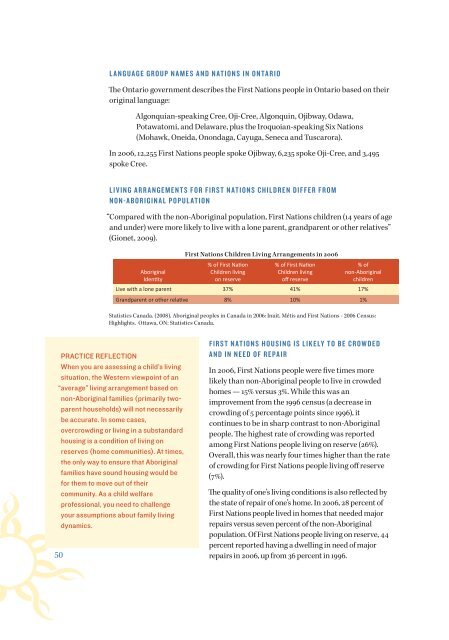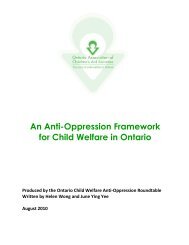English - Ontario Association of Children's Aid Societies
English - Ontario Association of Children's Aid Societies
English - Ontario Association of Children's Aid Societies
You also want an ePaper? Increase the reach of your titles
YUMPU automatically turns print PDFs into web optimized ePapers that Google loves.
LANGUAGE GROUP NAMES AND NATIONS IN ONTARIO<br />
The <strong>Ontario</strong> government describes the First Nations people in <strong>Ontario</strong> based on their<br />
original language:<br />
Algonquian-speaking Cree, Oji-Cree, Algonquin, Ojibway, Odawa,<br />
Potawatomi, and Delaware, plus the Iroquoian-speaking Six Nations<br />
(Mohawk, Oneida, Onondaga, Cayuga, Seneca and Tuscarora).<br />
In 2006, 12,255 First Nations people spoke Ojibway, 6,235 spoke Oji-Cree, and 3,495<br />
spoke Cree.<br />
LIVING ARRANGEMENTS FOR FIRST NATIONS CHILDREN DIFFER FROM<br />
NON-ABORIGINAL POPULATION<br />
“Compared with the non-Aboriginal population, First Nations children (14 years <strong>of</strong> age<br />
and under) were more likely to live with a lone parent, grandparent or other relatives”<br />
(Gionet, 2009).<br />
Aboriginal<br />
Identity<br />
First Nations Children Living Arrangements in 2006<br />
% <strong>of</strong> First Nation<br />
Children living<br />
on reserve<br />
% <strong>of</strong> First Nation<br />
Children living<br />
<strong>of</strong>f reserve<br />
% <strong>of</strong><br />
non-Aboriginal<br />
children<br />
Live with a lone parent 37% 41% 17%<br />
Grandparent or other relative 8% 10% 1%<br />
Statistics Canada. (2008). Aboriginal peoples in Canada in 2006: Inuit, Métis and First Nations - 2006 Census:<br />
Highlights. Ottawa, ON: Statistics Canada.<br />
PRACTICE REFLECTION<br />
When you are assessing a child’s living<br />
situation, the Western viewpoint <strong>of</strong> an<br />
“average” living arrangement based on<br />
non-Aboriginal families (primarily twoparent<br />
households) will not necessarily<br />
be accurate. In some cases,<br />
overcrowding or living in a substandard<br />
housing is a condition <strong>of</strong> living on<br />
reserves (home communities). At times,<br />
the only way to ensure that Aboriginal<br />
families have sound housing would be<br />
for them to move out <strong>of</strong> their<br />
community. As a child welfare<br />
pr<strong>of</strong>essional, you need to challenge<br />
your assumptions about family living<br />
dynamics.<br />
50<br />
FIRST NATIONS HOUSING IS LIKELY TO BE CROWDED<br />
AND IN NEED OF REPAIR<br />
In 2006, First Nations people were five times more<br />
likely than non-Aboriginal people to live in crowded<br />
homes — 15% versus 3%. While this was an<br />
improvement from the 1996 census (a decrease in<br />
crowding <strong>of</strong> 5 percentage points since 1996), it<br />
continues to be in sharp contrast to non-Aboriginal<br />
people. The highest rate <strong>of</strong> crowding was reported<br />
among First Nations people living on reserve (26%).<br />
Overall, this was nearly four times higher than the rate<br />
<strong>of</strong> crowding for First Nations people living <strong>of</strong>f reserve<br />
(7%).<br />
The quality <strong>of</strong> one’s living conditions is also reflected by<br />
the state <strong>of</strong> repair <strong>of</strong> one’s home. In 2006, 28 percent <strong>of</strong><br />
First Nations people lived in homes that needed major<br />
repairs versus seven percent <strong>of</strong> the non-Aboriginal<br />
population. Of First Nations people living on reserve, 44<br />
percent reported having a dwelling in need <strong>of</strong> major<br />
repairs in 2006, up from 36 percent in 1996.

















